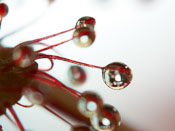Cultivation
Drosera
About 200 species belong to the genus Drosera (sundew). The many different species, all of which catch their prey using adhesive droplets (active trap),
can be roughly divided into a few sub-groups:
Tuberous Drosera (survive the dry season as a tuber), pygmy Drosera (remain relatively small and mainly reproduce vegetatively via gemmae),
petiolaris Drosera (tropical species that protect against dehydration using various strategies), tropical and subtropical Drosera
(Queensland Drosera, etc.) , tempered Drosera (survive the unfavorable season in hibernacles etc.).
Overall, this genus is one of the most diverse among carnivorous plants. Here are some species in detail:
Queensland Drosera - Subtropical Drosera - Pygmy Drosera
Queensland Drosera
Light: shady
Humidity: >80 %
Temperature: all year around 20-30 °C
Substrate: Peat-sand mixture
Watering: Pot always in about 1 cm of water
Propagation: Leaf cuttings, plantlets via flower stalk
Drosera prolifera
My own experience:
Drosera prolifera is one of my favorite Drosera. It belongs to the four "Queensland Drosera" and has a very small,
but still beautiful pink flower.
I first cultivated this plant on the south side, but whenever the sun reached it, the droplets disappeared.
So I put it next to the north window. There it visibly felt comfortable and sometimes even had up to ten leaves with intact droplets.
Incidentally, it always blooms in summer and produces many small plants on all flower stalks.
Level of difficulty: 



Drosera schizandra
My own experience:
This plant may look like a kind of green salad, but since I like Queensland Drosera in general, I couldn't avoid Drosera schizandra.
Incidentally, I do not water this plant at all, since it is in a puddle of condensed water that runs down the wall of the terrarium.
Nor can I really confirm that it is extremely difficult. It only grows a little slower than Drosera prolifera and is sometimes a bit susceptible to fungal infections,
which is why it is better to use something airy like sphagnum as a substrate. Unfortunately, this species is also relatively blooming lazy.
Level of difficulty: 



Subtropical Drosera
Light: Bright
Humidity: >60 %
Temperature: all year around 20-25 °C, or colder in winter: 10-15 °C
Substrate: Peat-sand-perlite mixture
Watering: Pot always in about 1 cm of water
Propagation: Seeds, root cuttings,leaf cuttings
Drosera binata
My own experience:
Drosera binata was one of my first plants. Out of inexperience, I put them on the north side without knowing that this species needs a lot of light.
I forgot to water them a few times. When I repotted it for the first time, I found that this extremely thirsty plant consists almost entirely of roots.
Today I really wonder how it could survive on the windowsill all those years. Oddly enough, it even bloomed regularly.
I can also confirm that it is a great insect catcher. It catches snakes, flies, butterflies, spiders etc.
For several years I have been successfully cultivating a relatively hardy form of this species in the bog garden.
Level of difficulty: 

Drosera capensis
My own experience:
This plant is very suitable for beginners. It can be easily propagated via seeds and grows extremly well.
It is sufficient if you place the plant at a bright window and always pour it with rainwater so that the pot is slightly standing in 1 com of water.
Level of difficulty: 


Drosera hamiltonii
My own experience:
In the beginning, this species turned out to be a bit iffy: from one day to the next, all the droplets disappeared, but then they suddenly reappeared again.
At some point I just didn't believe I would ever see the beautiful pink flower.
Seeds of this species are not to be considered anyway, because, to make matters worse, it is also self-sterile (you need two genetically different plants).
But then I got a little bit closer to a flower. Supposedly, a larger or deeper pot should lead to success.
Since the roots of my plant already grew from the bottom of the pot, I placed the pot in another pot, which made the pot depth about 13 cm in total.
My plan worked and it finally flowered. Unfortunately I do not know whether the cold winter (approx. 10 °C) or the deep pot was responsible for it.
Since then, my plants have never bloomed again.
Level of difficulty: 



Pygmy Drosera
Light: bright
Humidity: >60 %
Temperature: Summer: 20-30 °C, colder during winter
Substrate: Peat-sand mixture
Watering: Pot always in about 1 cm of water, in Sommer drier
Propagation: Gemmae, (Seeds)
Drosera pulchella
My own experience:
In 2006 I received a few plants, but sciarids made a very quick end to the sensitive roots, and therefore the plant.
I was able to harvest a few seeds in time, but unfortunately the hoped-for germination failed to materialize.
Around the end of 2007 I bought some gemmae again. In the beginning they grew quite well, but then I accidentally left all my Pygmy Drosera on the balcony.
It was very cold at night and many plants died. A few D. pulchella didn't survive and the rest also didn't look very well.
But a few weeks later they still managed to bloom!
In the years that followed, however, the whole cultivation was much more successful.
Level of difficulty: 





